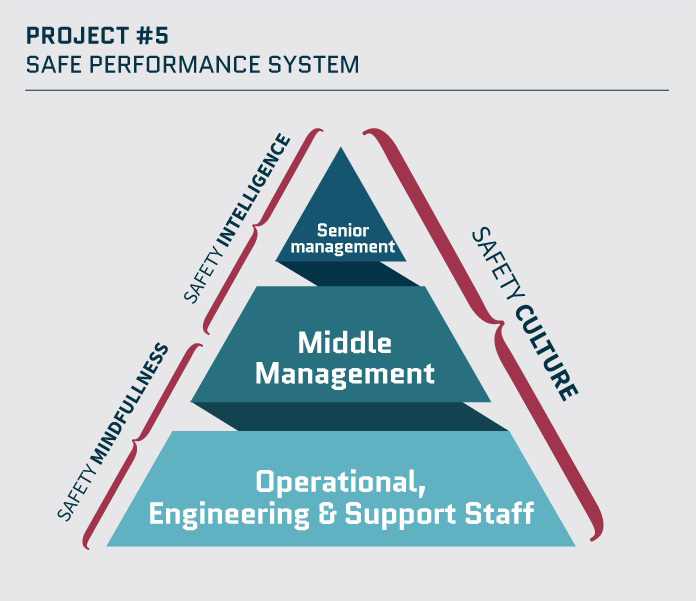Project #5
Resolving the organisational accident
Type of Project
Collaborative Project
Theme
Building Ultra-resilient Systems and Operators
What is Project #5 about?
The objective of P5 “Resolving the organisational accident” is to reduce the likelihood of organisational accidents in aviation via development and implementation of a Safe Performance System.
Safety focus has traditionally been on technical failures and human error as they occur in operations, while new and promising approaches consider the overall socio-technical system in the full operational and organisational context. This Project addresses effects of organisational structures, processes & cultural phenomena on safety performance in aviation organisations, and the key areas comprising the resolution of next aviation accidents are safety intelligence, safety culture, safety mindfulness and an agile response capability at organisational and inter-organisational levels. These elements are all available, but they need to be focused on the daily realities of aviation-related organisations, and then integrated into a cohesive system that will work for all parts of the aviation industry, whether ground or air, operational or support.
P5 answers to Theme 3 “Building ultra-resilient systems and operators”, which aims at strengthening the resilience to deal with current and new risks of the humans and the organisations operating the air transport system.
Project Manager: EUROCONTROL

P5 “Resolving the organisational accident” is divided in 5 technical Work Packages.
WP5.1 – Executive Safety Intelligence
The main goal of this WP is to ensure that those at the so-called ‘blunt end’ (political, senior and middle-managers) understand how safety works in the Air Transport System, how they can lead safety, and how their decisions shape safety performance. This will include guidance on safety culture leadership, and usage of tools such as safety dashboards and data feeds to ensure safety decision making.
WP5.2 – Safety Mindfulness
WP5.2 aims at developing and demonstrating a practical method of maintaining safety mindfulness in operational situations by maintaining feed-forward of risk information and feedback from operations.
WP5.2 will determine how to maintain and foster safety mindfulness in the context of real and agile (dynamically changing; flexible) operations. Using Human Factors approaches and socio-technical modelling, the work will examine, characterise and develop safety decision-making, and determine how safety emerges at middle and operational/support layers.
WP5.3 – Safety Culture
WP5.3 works to optimise the collective safety culture of the European aviation industry. It will do this by analysing the results of safety culture surveys and developing optimised safety culture profiles for clusters of European national and professional cultures. Different national cultures and different professions have different ways of being safe, and these need to be (a) identified and (b) harmonised into a manageable set of aspirational profiles. The final outcome is a method for assessing and reporting on safety culture across a whole aviation system, with areas for improvement being identified and tailored to different cultural contexts.
WP5.4 – Agile Response Capability
This Work Package will develop an organisational and inter-organisational capability to respond to rapidly evolving crisis events in an effective and resilient manner, and explore aspects of risks and crises that change at a slower pace with longer-term dynamics. The response capability will be able to address events focusing on sudden crises and exploring aspects of the continuum towards risks that change at a slower pace with longer-term dynamics.
WP5.5 – Safe Performance System
The objective of this work package is to demonstrate how a safe performance system can be established. This implies integrating the results of WP5.1 to WP5.4 into a cohesive and coordinated approach, selecting case studies to illustrate its functioning, and developing training materials to allow Air Transport System organisations to integrate it into their operational management and processes and activities.
The main Project outcome will be development and implementation of a Safe Performance System, a ‘second generation’ safety management system, one that is at the heart of operations, giving all levels in the organisation a better ‘safety radar’.
P5 is expected to produce/develop:
- A set of related (cascaded) Safety Dashboards for different levels in the organisation.
- A portfolio of static and interactive executive safety intelligence media to impart the safety understanding required at political, senior and middle management levels, and encourage top down safety leadership.
- A safety culture scorecard for reporting safety culture performance within an international aviation system (e.g. ATM), with results calibrated for different cultural clusters, and areas for improvement identified.
- Operational Mindfulness Manager – a model-based interface presenting the key states, gates and dependencies to be managed by operational staff and crew with feedback to system risk analysis and feed-forward of current risk information.
- An agile Safe Performance System that can be adopted by Air Transport System organisations and mapped onto their operational management structure, processes and working arrangements.

| Deliverables | |
|---|---|
| D5.1 | Executive Safety Intelligence for CEO/Board and political level |
| D5.2 | Safety Mindfulness Concept |
| D5.3 | Agile Response Capability (ARC) best practices |
| D5.4 | Optimized safety culture profiles tailored to national cultures |
| D5.5 | Executive Safety Intelligence for Middle Managers |
| D5.6 | Safety Mindfulness Methodology |
| D5.7 | Agile Response Capability – scenario testing |
| D5.8 | Agile Response Capability (ARC) protocols and guidance |
| D5.9 | Executive Safety Intelligence Tool |
| D5.10 | Application cases for Safe Performance System |
| D5.11 | Executive Safety Intelligence Toolset |
| D5.12 | Operational Mindfulness Manager |
| D5.13 | Mapping of safety culture onto processes and principles |
| D5.14 | SPS guidance and supporting material |





